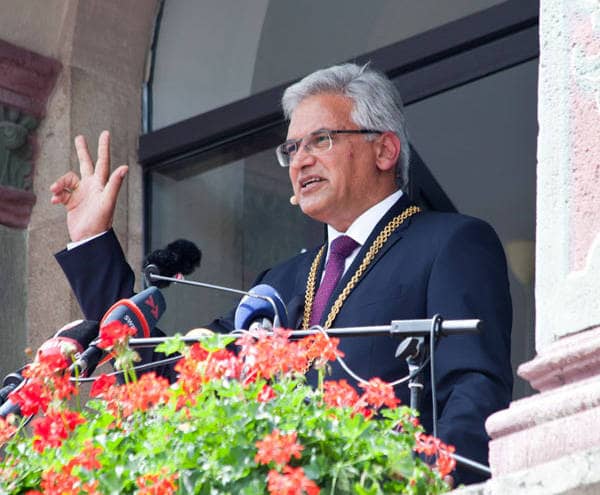Schwörmontag (Oath Monday)

© Stadt Ulm
To “serve rich and poor alike” – that is to work equally for all citizens: this is the oath first defined in 1345 and sworn by Ulm's Lord Mayor every year on Oath Monday, a unique legal tradition. Then they celebrate – first on the Danube and then throughout the city.
Oath Monday is Ulm's day. It falls on the second to last Monday in July. Political Ulm looks forward to the oath ceremony, during which the Lord Mayor gives an account of the year. It marks the beginning and end of the political year in Ulm, after which local government takes a summer recess.
Those who find the oath ceremony a little dry look forward to the “Nabada” water festival on the Danube in the afternoon, which might best be described to non-locals as a carnival-like celebration on the water. And fans of merry gatherings of a different kind excitedly await the mass party in the evening, which is also great for children, who get to release their lanterns in Friedrichsau Park.
The adults no longer just confine themselves to Friedrichsau Park though, as was the custom until the 1980s. The city centre resembles a witch's cauldron with a great steaming mass of people enjoying the party atmosphere. Live concerts to suit every taste are offered in at least a dozen places. The biggest is on Münsterplatz, which plays host to a top-class open-air party the night before Oath Monday, attracting thousands of spectators.
What is an “Oath Monday”? Who is swearing what to whom and why? It is Ulm's Lord Mayor who appears on the balcony of the Schwörhaus, first reporting to the citizens on what has happened in the city since the last Oath Monday. He then raises his right hand and swears to the people of the city, to serve rich and poor alike without reservation in all equal, common and honest dealings, so help him God. This is the wording of the oath that ends the annual oath speech. This oath is at least six and a half centuries old. It is recorded in the city's first constitution, which not only the Mayor, but also the citizens pledge to uphold each year in Ulm, and which was most likely adopted in 1345. Back then, the Mayor was still using good Middle High German, swearing, “ain gemainer man ze sin richen und armen uf alliu gemainiu und redlichiu ding”.
The phrase rich and poor refers more to social position than wealth: it was the official way of describing the two most important groups, namely the city's gentry, also known as “patricians” or “noble houses”, and the guilds. The Mayor was always a patrician. His promise of wanting to serve both groups equally was extremely significant at that time. In the 14th century, the economically strong guilds were fighting for a share of political power in Ulm, as they were elsewhere, that was commensurate with their economic position.
Even today, a glance at the Minster in Ulm reveals a daily reminder of how strong they were. Their true strength is not actually revealed by the highest church tower in the world, as the record of 161.53 metres was only achieved when it was completed in 1890. The true significance lies in the fact that the Minster, founded in 1377, is the largest people's church in the German-speaking world.
This means: the Minster was not financed by any ecclesiastical or worldly potentates, but by the residents of the city. And it may be argued that the patricians' funds alone were insufficient. Thus, Ulm Minster is a visible sign that the city was flourishing economically in the 14th century – and that was down to the guilds.
However, bitter conflicts ensued – which were truly bloody according to legend – before they were able to achieve the political influence they were entitled to. The constitution of 1345 mentioned above, also known as the Kleiner Schwörbrief (“Little Oath Proclamation”), records that the guilds held the majority of council seats. This had 32 members, 17 of whom came from the guilds and 15 from the gentry – including the Mayor.
However, this relatively narrow majority does not seem to have been enough to break patrician domination. Despite the annual collective oath pledging peaceful co-existence, new conflicts erupted, but it was the guilds that emerged victorious once again. The council got 40 new members, of whom 30 came from the guilds and only 10 from the patrician class. The guilds now had a winning majority of 47:25. These new conditions were laid down in the constitution of 1397, the Großer Schwörbrief (“Great Oath Proclamation”). It was now this new constitution that the city's ruling council and people pledged to uphold year after year on St George's Day, 23rd April. This tradition was brought to an abrupt end though by Emperor Charles V in August 1548. He wanted to break the influence of the guilds, banned them, chased their representatives from the council and reduced this body to 32 members. This also meant a temporary end to Oath Monday. The people of Ulm were not happy with this state of affairs, however, and eventually succeeded in restoring their customary constitution day celebrations. By 1558, Oath Monday was once again being celebrated in the old way.
The ratios of political strength had reversed though: the council, increased to 42 members since 1556, remained under patrician control. And something else had changed: the annual council elections had to take place in August, commemorating the imperial ban on guilds, and Oath Monday, which was held three days later, was celebrated on the Monday of St. Lawrence week (St. Lawrence's Day = 10th August).
That's how things stayed until Ulm lost its Free Imperial City status in 1802 and became Bavarian. This meant the city no longer had its own constitution that needed to be confirmed by oath.And that meant Oath Monday had lost its meaning. Other cities experienced this too, as an oath day was by no means a peculiarity of Ulm, but in fact was a common event in the cities of southern Germany and Switzerland, as well as further north. What does make Ulm different, however, is the stubbornness with which the people continue to support their oath day even now.
You can see this in the enthusiasm with which the social aspect at least, namely the celebrations, continued undaunted, with loud demands for the restoration of the political side of Oath Monday continuing until the start of the 20th century.It cannot be denied that it was the Nazis, with their distinctive flair for propaganda, who skilfully embraced this desire and enthroned their Lord Mayor on Oath Monday in 1933 with a huge event in the stadium.The Lord Mayor's annual report on the city is also their invention.Nevertheless, Ulm retained the political side of Oath Monday after the War. While the Nazis might have used the event to promote ideas of leadership and following, the focus now is on the democratic element. The old form of the oath was restored and, translated into New High German, has been sworn by Ulm's Lord Mayors every year since 1949. Perhaps some may question whether an oath, which normally has no expiry date, is that robust if it has to be proclaimed by a city leader once a year. The answer lies in the Imperial City era. Back then, as mentioned above, the Mayor was re-elected each year and took his oath of office on Oath Monday.

© Stadt Ulm
Nowadays of course, Ulm's Lord Mayors only take their official oath of office once, on taking power. No-one sees this extra oath taken once a year to work equally for all as a sign of reduced credibility. Ultimately this is a tradition.
The place where the oath ceremony takes place, the Weinhof, is also full of tradition. It is the oldest part of the city. It was the site of the royal palace, where the document first mentioning Ulm's existence was sealed on 22nd July 854. The oath has always been sworn here, first in a “Schwörhäuslein” (Little Oath House), an arcade attached to the tower of the palace chapel. The tower and chapel were demolished and replaced by a new Schwörhaus in 1612, which is unique. Ulm is the only city to have such a splendid purpose-built house for this oath ceremony held once a year. It burnt down in 1785, but was rebuilt four years later. After severe damage during the Second World War, the Schwörhaus was “re-opened” on Oath Monday 1954 for Ulm's 1,100th anniversary.The water festival is now an indispensable part of Oath Monday. During the Imperial City era, the Fischerstechen (“Fishermen's Jousting”) tournament was held every two years on the Tuesday after Oath Monday, and in the years since the fishermen also paid homage to the custom of the “Bäuerle-Herunterfahren”.
This was a rowdy event on the Danube and is seen as the forerunner of today's Nabada festival. Other elements were added during the 19th century, like the Biedermeier water cruises and water pantomimes, which were also held on many an oath day. The name “Nabada” comes from a simple summer bathing activity, which was enjoyed at the rest stops. This has since developed into a veritable carnival in the Danube. Since 1967, the city has also enjoyed the “Serenade of Lights” (Lichterserenade), during which 8,000 lights glide down the Danube on the Saturday before Oath Monday, having been released onto the water from the traditional“Ulmer Schachtel” boats. The week before Oath Monday is filled with events. Every four years, the Fishermen's Jousting tournament is held before Oath Monday and – alternating – likewise every four years, Ulm's Bindertanz (“Coopers' Dance”). Oath Monday is the celebratory focus of the year for Ulm. It has always been so and that may also be why it is the only oath day to have survived the end of the Imperial Cities – and is more popular today than ever.
